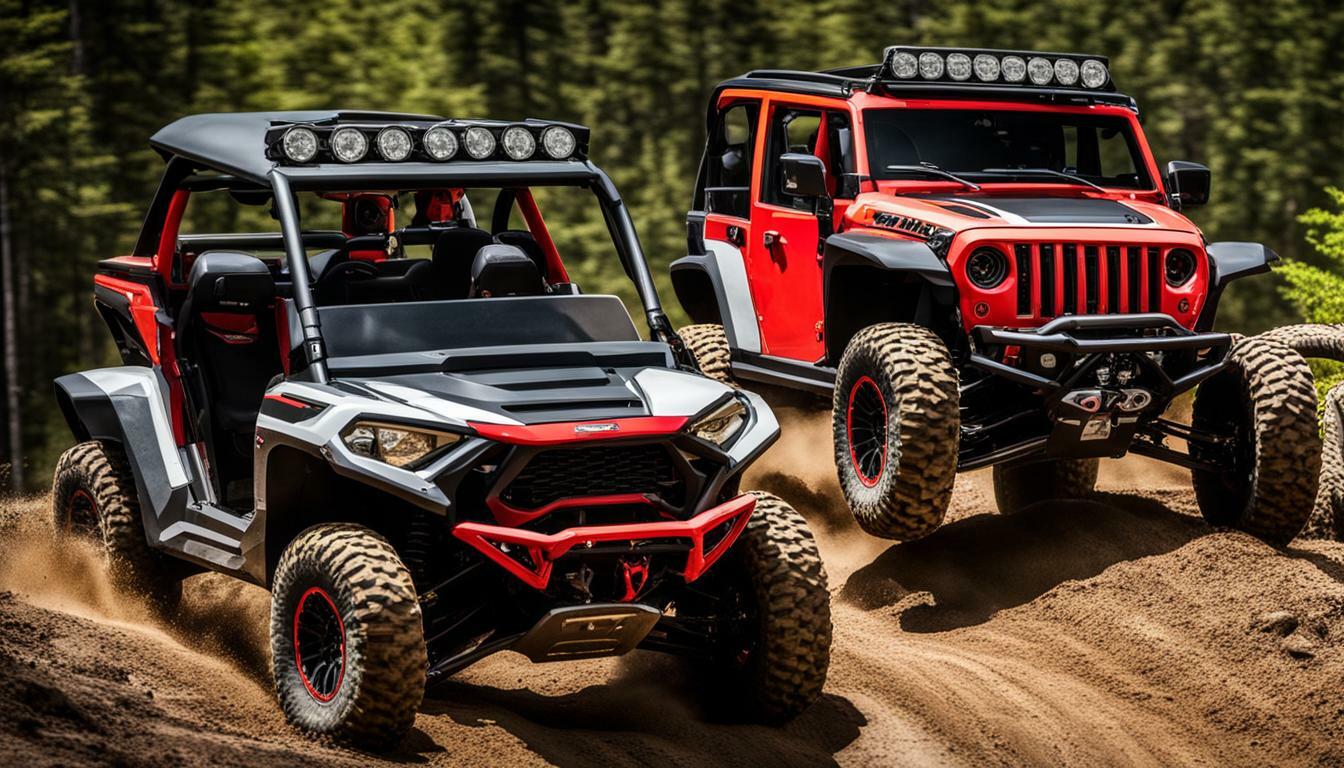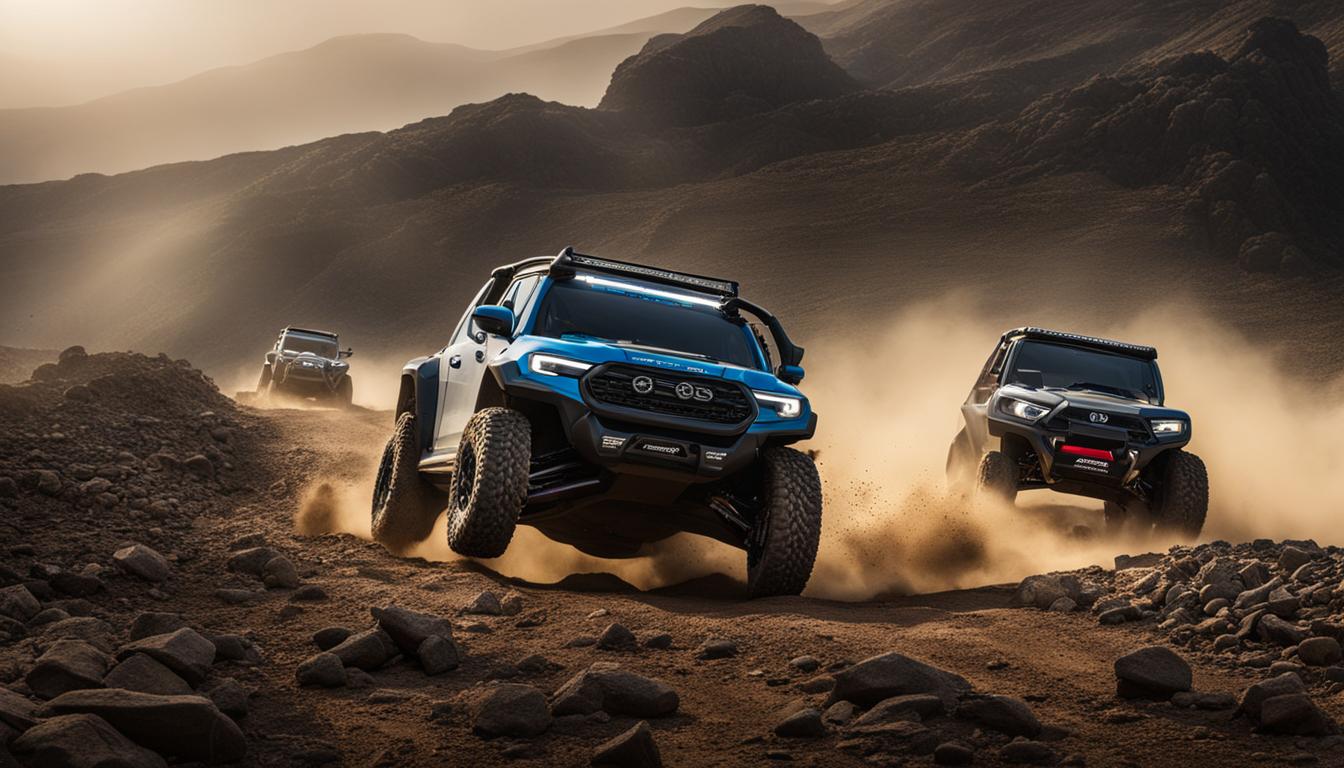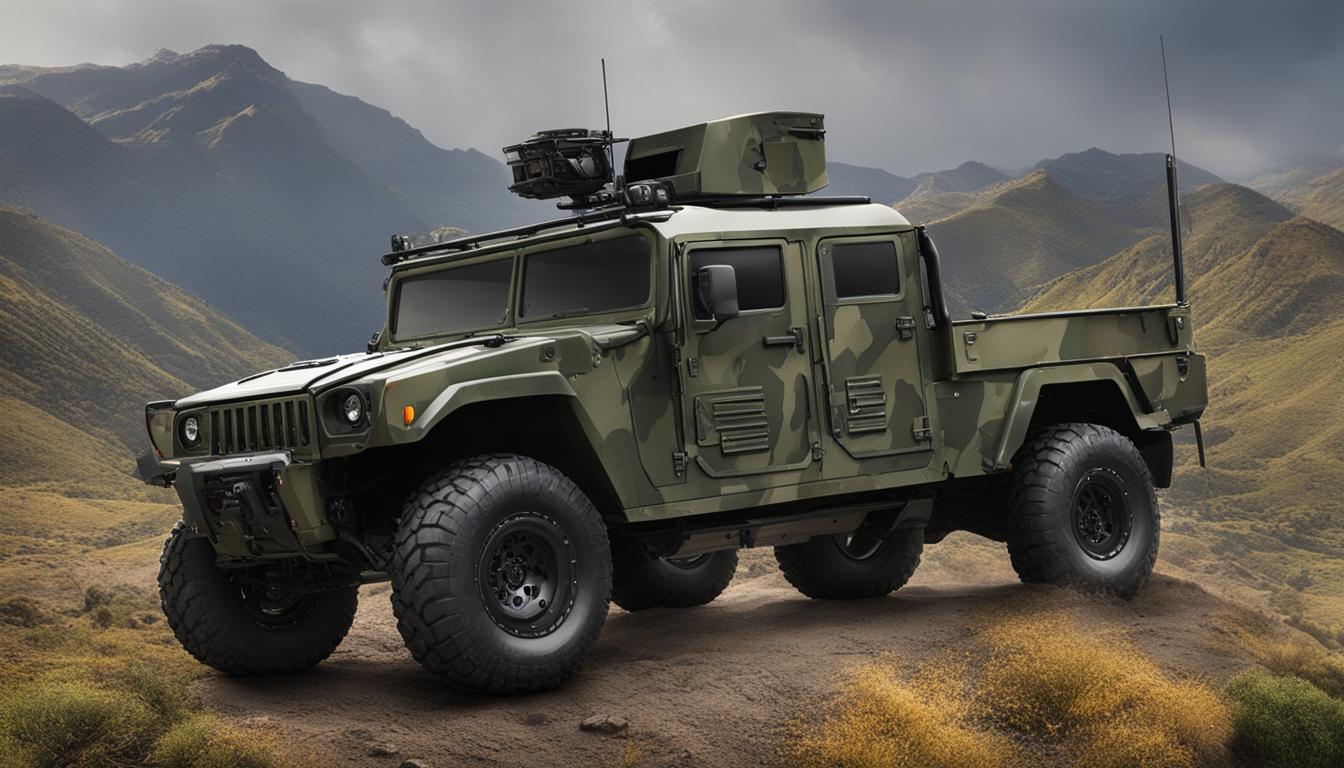When it comes to off-roading, the choice between solid axle and independent suspension can significantly impact your vehicle’s performance and capabilities. These two suspension systems have distinct differences in design and handling, making them suitable for various terrains and obstacles.
Key Takeaways:
- Solid axle suspensions, also known as beam axles or live axles, connect both wheels on an axle to a single housing.
- They offer durability, ease of repair, handle heavy loads, and provide increased wheel travel, making them ideal for off-road use and rock crawling.
- However, solid axle suspensions provide a stiff ride, poor handling at high speeds, and can be rough on bumpy terrains.
- Independent suspensions allow each wheel to move independently, providing smoother rides, better handling, and more precise steering.
- They are commonly found in modern vehicles and are suitable for daily driving and higher speeds.
- However, independent suspensions are more expensive to repair and offer less wheel travel compared to solid axles.
- The choice between solid axle and independent suspension depends on individual preferences, budget, and the intended use of the vehicle.
Understanding Solid Axle Suspension
Solid axle suspension, also known as beam axle or live axle, is a robust and durable system that has been a staple in off-road vehicles for many years. This type of suspension setup connects both wheels on an axle to a single axle housing, allowing them to move in unison. When one wheel encounters an obstacle, it directly impacts the wheel on the other side. This design provides several benefits for off-roading enthusiasts.
One of the main advantages of solid axle suspension is its durability. The single axle housing effectively distributes the load and can withstand heavy loads, making it ideal for tackling off-road challenges. Additionally, solid axle suspensions have fewer moving parts compared to independent suspension systems, resulting in simplified maintenance and repair processes. This makes them a popular choice among off-roaders who value reliability and ease of maintenance.
Another key feature of solid axle suspensions is their ability to offer increased wheel travel. Wheel travel refers to the distance that the wheels can move up and down from their neutral position. With solid axle suspensions, the wheels have more vertical movement, allowing them to better navigate rough terrains and obstacles such as rocks and uneven surfaces. This increased wheel travel is particularly advantageous for activities like rock crawling, where the vehicle needs to maintain traction and stability at extreme angles.
However, it’s important to note that solid axle suspensions do have some drawbacks. Due to their design, they tend to provide a stiffer ride compared to independent suspension systems. This can result in a less comfortable experience on bumpy terrains. Additionally, solid axle suspensions may exhibit poorer handling at high speeds, as the movement of one wheel can affect the other. Despite these limitations, solid axle suspensions remain a popular choice for off-road enthusiasts who prioritize durability, heavy load capacity, and increased wheel travel.
| Benefits of Solid Axle Suspension |
|---|
| Durability |
| Ease of maintenance and repair |
| Ability to handle heavy loads |
| Increased wheel travel for off-road challenges |
Exploring Independent Suspension Off-Roading
Independent suspension systems have revolutionized off-roading, offering improved handling and performance on various terrains. Unlike solid axle suspensions, which connect both wheels on an axle, independent suspensions allow each wheel to move independently when encountering bumps or obstacles. This means that one wheel can move up or down without directly affecting the other wheel, resulting in a smoother ride, better handling, and more precise steering.
One of the key advantages of independent suspension in off-roading is its ability to maintain tire contact with uneven surfaces. Each wheel can independently react to the terrain, allowing the vehicle to better navigate obstacles without losing traction. This is especially beneficial when traversing rocky terrains or when encountering undulating surfaces.
Additionally, independent suspension systems offer increased wheel articulation, allowing the wheels to move up and down with more freedom. This improved wheel travel allows for better traction and better weight distribution, enhancing the vehicle’s off-road capabilities. It also helps in maintaining stability and minimizing the risk of wheel lift or loss of contact with the ground.
Another advantage of independent suspension in off-roading is its impact on ride comfort and handling. The independent movement of each wheel helps to absorb shocks and vibrations, resulting in a smoother and more comfortable ride for occupants. Moreover, the precise steering control offered by independent suspensions allows for better cornering and maneuverability, enabling off-road enthusiasts to navigate tight trails and challenging obstacles with ease.
| Advantages of Independent Suspension in Off-Roading |
|---|
| Improved handling on various terrains |
| Enhanced wheel articulation and traction |
| Increased ride comfort and stability |
| Precise steering control for better maneuverability |
In conclusion, independent suspension systems have revolutionized off-roading by offering improved handling, enhanced traction, and increased ride comfort. These systems allow each wheel to move independently, maintaining tire contact with uneven surfaces and providing better stability. With their increased wheel articulation and precise steering control, independent suspensions are an ideal choice for off-road enthusiasts looking to conquer challenging terrains with confidence.
How Solid Axle Suspension Handles Off-Road Challenges
Solid axle suspension excels in off-road scenarios, providing unparalleled durability and the ability to overcome challenging obstacles. Its design, with both wheels on an axle connected to a single axle housing, allows for increased wheel travel and superior handling in rugged terrains.
One of the key advantages of solid axle suspension is its ability to handle heavy loads. The single axle housing distributes the weight evenly across both wheels, ensuring stability and preventing excessive strain on individual components. This makes solid axle suspensions ideal for off-road vehicles that need to carry heavy cargo or equipment.
Another benefit of solid axle suspension is its suitability for rock crawling. The strong and robust construction of solid axles allows them to withstand the harsh impacts and forces encountered during rock crawling, providing maximum traction and stability. The increased wheel travel offered by solid axle suspension also allows for better articulation, enabling the vehicle to maintain contact with uneven surfaces and negotiate obstacles more effectively.
However, it’s important to note that solid axle suspensions do have some drawbacks. They tend to provide a stiffer ride compared to independent suspensions, which can result in a less comfortable experience on bumpy or uneven terrains. Additionally, solid axle suspensions may offer less precise steering and handling at higher speeds, making them less suitable for daily driving or situations that require quick maneuvers.
| Solid Axle Suspension | Independent Suspension |
|---|---|
| High durability | Smooth ride |
| Superior off-road performance | Precise steering |
| Handles heavy loads well | Better handling at high speeds |
In summary, solid axle suspension offers unmatched durability and off-road performance, making it an excellent choice for challenging off-road scenarios and rock crawling. While it may provide a stiffer ride and less precise steering at high speeds, these drawbacks are outweighed by its ability to handle heavy loads and conquer rugged terrains. Whether you choose solid axle or independent suspension ultimately depends on your preferences, budget, and the intended use of the vehicle.
The Advantages of Independent Suspension in Off-Roading
Independent suspension has gained popularity in off-roading due to its ability to deliver a comfortable and controlled ride on a range of terrains. Unlike a solid axle suspension, which connects both wheels on an axle, independent suspension allows each wheel to move independently. This means that when one wheel encounters an obstacle or bump, it can move up or down without affecting the other wheel. This level of independence provides several key advantages for off-road enthusiasts.
One of the main benefits of independent suspension in off-roading is improved handling. With each wheel able to react independently to uneven terrains, the vehicle maintains better stability and traction. This allows for better maneuverability and control, especially in challenging off-road conditions. Independent suspension also offers more precise steering, allowing drivers to navigate tight corners and obstacles with ease.
Another advantage is the smoother ride offered by independent suspension systems. The ability of each wheel to move independently helps to absorb shocks and vibrations from uneven surfaces, providing a more comfortable experience for passengers. This is particularly important when traversing rough terrains or tackling long off-road journeys. The improved ride quality offered by independent suspension can reduce driver fatigue and enhance overall enjoyment during off-roading adventures.
Furthermore, independent suspension systems offer greater flexibility and adaptability. They can be adjusted and customized to suit specific off-road requirements, such as achieving optimal ground clearance or accommodating different tire sizes. This versatility allows off-road enthusiasts to tailor their vehicles to their preferences and the specific challenges they may face during their off-road adventures. Whether it’s rock crawling, desert dune bashing, or muddy trails, independent suspension systems can enhance performance and optimize the off-roading experience.
| Advantages of Independent Suspension in Off-Roading |
|---|
| Better handling and stability on uneven terrains |
| Improved ride quality and comfort for passengers |
| Customizable and adaptable to suit off-road requirements |
Comparing Solid Axle and Independent Suspension
When choosing between solid axle and independent suspension, it’s essential to consider the trade-offs in performance, repairability, and flexibility. Solid axle suspensions, also known as beam axles or live axles, offer durability and ease of repair. They are commonly found in older vehicles and models like the Jeep Wrangler JL. Solid axles are known for their ability to handle heavy loads and provide increased wheel travel, making them suitable for off-road use and rock crawling.
On the other hand, independent suspension systems allow each wheel to move independently, providing smoother rides and better handling compared to solid axles. Independent suspensions are commonly found in modern vehicles and are ideal for daily driving and higher speeds. However, they are more expensive to repair due to their complex design and offer less wheel travel compared to solid axles.
In terms of performance, solid axle suspensions excel in off-road scenarios where durability and heavy load handling are crucial. They can easily handle challenging terrains, including rock crawling. On the other hand, independent suspensions offer superior handling, smoother rides, and more precise steering, making them ideal for daily driving and higher speeds.
| Solid Axle Suspension | Independent Suspension | |
|---|---|---|
| Handling | Poor at high speeds, suitable for off-road | Better handling, ideal for daily driving and higher speeds |
| Ride Quality | Stiff and rough on bumpy terrains | Smoother rides |
| Repair Costs | Easier and less expensive to repair | More complex design, higher repair costs |
| Wheel Travel | Increased wheel travel, suitable for off-road | Less wheel travel |
In conclusion, the choice between solid axle and independent suspension depends on individual preferences, budget, and the intended use of the vehicle. Solid axle suspensions are favored for their durability, heavy load handling, and increased wheel travel, making them suitable for off-road adventures and rock crawling. Independent suspensions offer better handling, smoother rides, and more precise steering, making them ideal for daily driving and higher speeds. Consider the trade-offs in performance, repairability, and flexibility when deciding which suspension system is best for your needs.
Conclusion
In conclusion, both solid axle and independent suspension have their advantages and disadvantages, and the choice ultimately depends on your off-roading needs and preferences.
A solid axle suspension, also known as a beam axle or live axle, offers durability, ease of repair, and the ability to handle heavy loads. It is commonly found in older vehicles and models like the Jeep Wrangler JL. Solid axles are suitable for off-road use and rock crawling due to their increased wheel travel. However, they provide a stiff ride, poor handling at high speeds, and can be rough on bumpy terrains.
On the other hand, independent front suspension (IFS) setups allow each wheel to move independently, providing smoother rides, better handling, and more precise steering. Independent suspensions are commonly found in modern vehicles and are ideal for daily driving and higher speeds. However, they are more expensive to repair due to their complex design and offer less wheel travel compared to solid axles.
Ultimately, the choice between solid axle and independent suspension depends on individual preferences, budget, and the intended use of the vehicle. If you prioritize durability, heavy load handling, and off-road capabilities, solid axles may be the better option. If you prefer better handling, smoother rides, and precise steering for daily driving and higher speeds, independent suspensions are recommended. Consider your off-roading needs and preferences before making a decision.
FAQ
What is the main difference between solid axle and independent suspension in off-roading?
Solid axle suspension connects both wheels on an axle to a single axle housing, while independent suspension allows each wheel to move independently.
What are the benefits of solid axle suspension in off-roading vehicles?
Solid axle suspensions are known for their durability, ease of repair, ability to handle heavy loads, and increased wheel travel.
How does independent suspension differ from solid axle suspension in terms of performance?
Independent suspension provides smoother rides, better handling, and more precise steering compared to solid axle suspension.
Which type of suspension is more suitable for rock crawling?
Solid axle suspension is favored for its ability to handle heavy loads and increased wheel travel, making it suitable for rock crawling and off-road use.
Is independent suspension more expensive to repair compared to solid axle suspension?
Yes, independent suspension systems generally tend to be more expensive to repair due to their complex design.
Which type of suspension is ideal for daily driving and higher speeds?
Independent suspension provides better handling, smoother rides, and more precise steering, making it ideal for daily driving and higher speeds.
How do solid axle and independent suspension systems differ in terms of wheel travel?
Solid axle suspensions offer increased wheel travel compared to independent suspensions.
Which factors should I consider when choosing between solid axle and independent suspension for my off-road vehicle?
The choice between the two depends on individual preferences, budget, and the intended use of the vehicle.
 Skip to main content
Skip to main content


